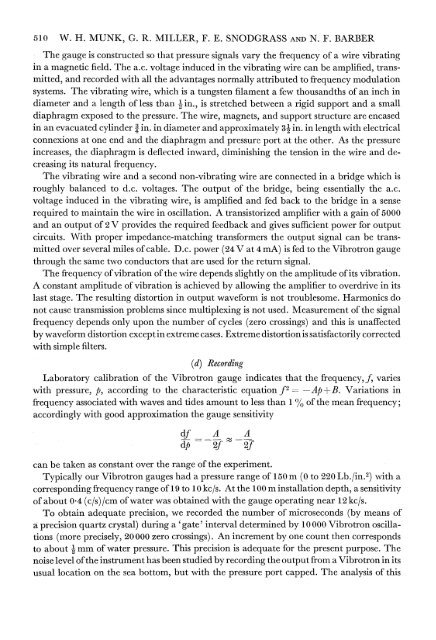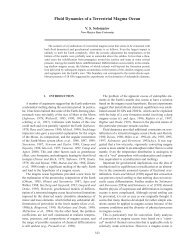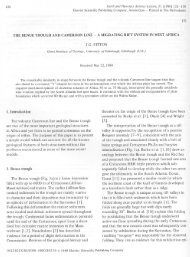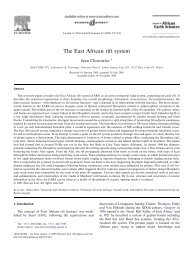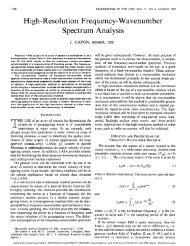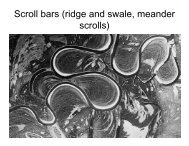Directional Recording of Swell from Distant Storms - Department of ...
Directional Recording of Swell from Distant Storms - Department of ...
Directional Recording of Swell from Distant Storms - Department of ...
Create successful ePaper yourself
Turn your PDF publications into a flip-book with our unique Google optimized e-Paper software.
510 W. H. MUNK, G. R. MILLER, F. E. SNODGRASS AND N. F. BARBERThe gauge is constructed so that pressure signals vary the frequency <strong>of</strong> a wire vibratingin a magnetic field. The a.c. voltage induced in the vibrating wire can be amplified, transmitted,and recorded with all the advantages normally attributed to frequency modulationsystems. The vibrating wire, which is a tungsten filament a few thousandths <strong>of</strong> an inch indiameter and a length <strong>of</strong> less tban 2 in., is stretched between a rigid support and a smalldiaphragm exposed to the pressure. The wire, rnagnets, and support structure are encasedin an evacuated cylinder 3 in. in diameter and approximately 31 in. in length with electricalconnexions at one end and the diaphragm and pressure port at the other. As the pressureincreases, the diaphragm is deflected inward, diminishing the tension in the wire and decreasingits natural frequency.The vibrating wire and a second non-vibrating wire are connected in a bridge which isroughly balanced to d.c. voltages. The output <strong>of</strong> the bridge, being essentially the a.c.voltage induced in the vibrating wire, is amplified and fed back to the bridge in a senserequired to maintain the wire in oscillation. A transistorized amplifier with a gain <strong>of</strong> 5000and an output <strong>of</strong> 2 V provides the required feedback and gives sufficient power for outputcircuits. With proper impedance-matching transformers the output signal can be transmittedover several miles <strong>of</strong> cable. D.c. power (24 V at 4 mA) is fed to the Vibrotron gaugethrough the same two conductors that are used for the return signal.The frequency <strong>of</strong> vibration <strong>of</strong> the wire depends slightly on the amplitude <strong>of</strong> its vibration.A constant amplitude <strong>of</strong> vibration is achieved by allowing the amplifier to overdrive in itslast stage. The resulting distortion in output waveform is not troublesome. Harmonics donot cause transmission problems since multiplexing is not used. Measurement <strong>of</strong> the signalfrequency depends only upon the number <strong>of</strong> cycles (zero crossings) and this is unaffectedby waveform distortion except in extreme cases. Extreme distortion is satisfactorily correctedwith simple filters.(d) <strong>Recording</strong>Laboratory calibration <strong>of</strong> the Vibrotron gauge indicates that the frequency,f, varieswith pressure, p, according to the characteristic equation f2- Ap+B. Variations infrequency associated with waves and tides amount to less than 1 % <strong>of</strong> the mean frequency;accordingly with good approximationi the gauge sensitivitydf A Adp 2f 2fcan be taken as constant over the range <strong>of</strong> the experiment.Typically our Vibrotron gauges had a pressure range <strong>of</strong> 150 m (0 to 220 Lb./in.2) with acorresponding frequency range <strong>of</strong> 19 to 10 kc/s. At the 100 m installation depth, a sensitivity<strong>of</strong> about 0 4 (c/s) /cm <strong>of</strong> water was obtained with the gauge operating near 12 kc/s.To obtain adequate precision, we recorded the, number <strong>of</strong> microseconds (by means <strong>of</strong>a precision quartz crystal) during a 'gate' interval determined by 10 000 Vibrotron oscillations(more precisely, 20 000 zero crossings). An increment by one count then correspondsto about 2 mm <strong>of</strong> water pressure. This precision is adequate for the present purpose. Thenoise level <strong>of</strong> the instrument has been studied by recording the output <strong>from</strong> a Vibrotron in itsusuallocation o)n the sea bottom, but with the pressure port capped. The analysis <strong>of</strong> this


